I realize that a mere ten days have passed since we officially festivized All Saints, which to my literal mind means we’re good for another year with everybody who has ever been beatified or canonized. But of course that isn’t the case, at least not here. Happily, saints often come not only with their often inscrutable life stories, but — as you may have noticed — with their own particular provender.
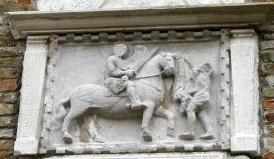
November 11 is the next case in point: It’s St. Martin’s Day (that would be St. Martin of Tours, if you’re looking for him — not the Caribbean island). And even though you may feel as if what’s left of the year is unspooling in a meaningless way — let’s just get to Christmas — there are several milestones on the way and he is one of the most important.
The man himself (316 to 397 A.D.) was born in what is now Hungary, and although he was drawn to Christianity at the age of ten, he followed his officer father and joined a Roman unit of heavy cavalry. He was pious but that didn’t seem to interfere with the performance of his duties, whatever those might have been. So everything was going along in a normal Roman-cavalry-unit sort of way until one day, near his base at Amiens, France, he had a life-changing experience, followed by a vision, which has become the most famous (usually only) thing which we remember about him. I refer to the Episode of the Cloak.
In the words of his hagiographer, Sulpitius Severus, “In the middle of winter, a winter which had shown itself to be more severe than ordinary, so that extreme cold was proving fatal to many, he happened to meet at the gate of the city of Amiens a poor man destitute of clothing. He was entreating those that passed by to have compassion upon him, but all passed the wretched man without notice, when Martin…recognized that a being to whom others showed no pity, was, in that respect, left to him.
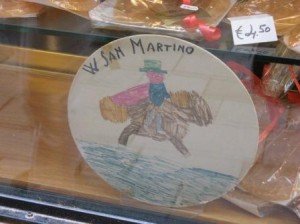
Yet, what should he do? He had nothing except the cloak in which he was clad, for he had already parted with the rest of his garments for similar purposes. Taking, therefore, his sword with which he was girt, he divided his cloak into two equal parts, and gave one part to the poor man, while he again clothed himself with the remainder. Upon this, some of the bystanders laughed, because he was now an unsightly object, and stood out as but partly dressed. Many, however, who were of sounder judgment, groaned deeply because they themselves had done nothing similar. They especially felt this, because, being possessed of more than Martin, they could have clothed the poor man without reducing themselves to nakedness.”
The first time I heard this story, I was slightly perplexed by the fact that he hadn’t given the man his entire cloak, him being such a good person, and then I figured he’d miraculously be given a new one (or something). Cutting it and keeping half seems so intelligent — hard to believe he became a saint with that approach to problem-solving.
But obviously I don’t know my saint. “In the following night” (Severus continues) …Martin…had a vision of Christ arrayed in that part of his cloak with which he had clothed the poor man…he heard Jesus saying with a clear voice to the multitude of angels standing around — “Martin, who is still but a catechumen, clothed me with this robe.”
Martin immediately went to be baptized, and two years later he left the army to begin a lifetime of good works and miracles. Many of his reported exploits seem somehow generic — no disrespect intended, I have no doubt these occurred or ought to have occurred (converting a robber to the Faith, restoring someone who had been strangled, destroying heathen temples and altars, casting out devils, curing the sick, preaching repentance to the Devil). He wouldn’t have been a saint if he hadn’t done at least two of those things. But clearly others also recognized his intelligence and made him Bishop of Tours, and then he became a national saint of France and also of soldiers. (I think that’s a fine thing to remember on Veterans’ Day.) But what remains fixed in millions of art works, and in most garden-variety minds, is the cloak-and-beggar story.
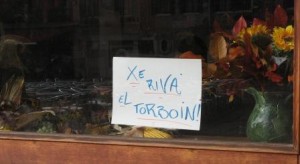
I can remember much of this because everyone here refers to that brief pause in the oncoming winter weather (known elsewhere as Indian Summer) as “St. Martin’s Summer.” It is underway even as I write, having arrived two nights ago, girt with smiling sunshine, after three days of ferocious cold, wind and rain. I also remember much of this because the kids go a little crazy.
This is an important date (unrelated to Martin, as such) because this is when anyone who made wine in September begins to decant the first stage, or “must,” a barely fermented fluid which here is called torbolino (tor-bo-LEE-no) because it’s turbid, and is born to be consumed with roasted chestnuts. And while the adults may be swallowing turbid wine and burning their fingers, the children head straight for sugar and noise.

The tradition is for children to go around the neighborhood banging and clanging on pots and pans with spoons or something, and carrying a small bag (sacco — sack. Sachetin — little sack. Sa-keh-TEEN). They sing at least the lilting refrain of a little song whose verses variously request any adult they stop to give them some kind of treat, and specifying the revenge they wish to see visited on anyone who refuses. “Pimples on your butt” is the best one. These are innocent little maledictions — nothing anyone could actually inflict, unlike Halloween tricks.
The correct term for this activity is “battere San Martino,” or “to beat St. Martin.” This simply means going out to make a racket in his honor. The refrain: “E co nooooooostro sachetiiiiiiiiin, Cari signori xe San Martin.” (And with our little sack, dear sirs it’s Saint Martin’s Day.)


They go in and out of whatever shops may be open — this is a late-afternoon/early-evening project — and may well score some kind of small candy or even bits of money. They are usually accompanied by squadrons of mothers.
Then there are the cookies called “Sammartini.” This is a newfangled post-war invention which played no part in the lives of children of Lino’s vintage. The dense buttery cookie dough is cut out by metal forms of various dimensions in the silhouette of a man on horseback holding his sword aloft. Then the pastry-makers go into a sort of frenzy decorating him with icing of various colors and sticking pieces of candy onto it before it dries. The price of these cookies varies according to size but also, I imagine, according to the elegance of the candy. An M&M is one thing, a Perugina chocolate is another. And then they add up the cost of the ingredients and multiply by, oh, a thousand. For the first time, I just saw some in the ordinary old supermarket, a triumph of economy over romance. It was bound to happen.
Speaking of economy, don’t worry too much about how much money the pastry-bakers could be losing on their unsold cookies the day after. They break them up into pieces and sell them by weight. That is really the triumph of economy over romance and I’m all for it. You know what? Fragments of saint taste just like the whole saint.


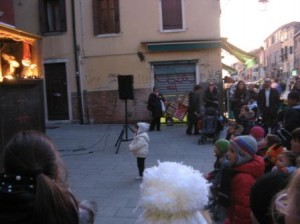
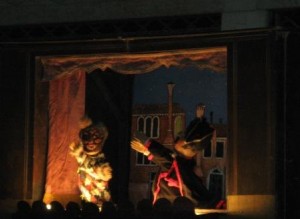
Back in the days when children were still made to memorize poetry, they were taught “San Martino” by Giosue Carducci ( Nobel Prize for Literature, 1906). It’s a bucolic little ode to this autumnal interlude — nothing about cloaks, saints, or sacks, small or otherwise — but naturally the new wine works its way into it with no trouble at all.
The poem comes rolling out of Lino’s memory even after all these decades; he just started reciting it yesterday as we were walking over the bridge on the way to the vaporetto. It’s more a hymn to the season than anything related to saints or miracles and it reminds me, in a way, of those lines from Stephen Vincent Benet’s “John Brown’s Body” (“Fall of the possum, fall of the ‘coon/And the lop-eared hound-dog baying the moon./Fall that is neither bitter nor swift/But a brown girl bearing an idle gift/A brown seed-kernel that splits apart/And shows the Summer yet in its heart…”). It’s a season that definitely brings out something in poets, maybe even more than spring.
La nebbia agli irti colli/piovigginando sale,/e sotto il maestrale/urla e biancheggia il mar;
Ma per le vie del borgo/dal ribollir de’ tini/Va l’aspro odor de i vini/l’anime a rallegrar.
Gira su ceppi accesi/lo spiedo scoppietando:/sta il cacciator fischiando/sull’uscio a rimirar
Tra le rossastre nubi/Stormi di uccelli neri/Com’esuli pensieri/Nel vespero migrar.
The mist on the bristly hills/rises drizzling/and under the northwest wind/the sea whitens and howls.
But in the village streets/from the fermenting tubs/Comes the pungent odor of the wine/to cheer the spirit.
Above the burning logs/the spit turns, popping;/the hunter whistling in the doorway/takes aim again
Among the russet clouds/flocks of black birds/like exiled thoughts/migrate at vespers.
By the way, Carducci was born in a Tuscan mountain village called Valdicastello (now Valdicastello Carducci, pop. 1000), so he wasn’t some urban creature sitting downtown inventing some fantasy out of the Georgics. He heard and saw (and smelled) what he was writing about. That’s why I like it. I wonder how old he was when the idea of “exiled thoughts” came to him.
Signing off for the Daily Saint and Cookie.


3 Comments
It’s the first time I see the “original” story by Sulpitius Severus, and I’m slightly perplexed, too. Because I had always imagined the saint on his horse wearing a knight’s armour (fashionable Roman cavalry style, probably without M&Ms), and the cloak on top of it. As you can’t easily divide an armour with your sword (or at least I hope so 😉 ) I found it understandable that he divided only the cloak. Although, yes, he could have given the whole cloak to the poor man, too.
But now Severus writes that he didn’t wear much below the cloak, and – it seems to me – his story implies that Martin might just have been out on an eveing walk in plain clothes, even (what a blasphemy!) without his horse 🙂 Interesting!
Thanks, too, for the poem by Giosue Carducci, it’s beautiful.
Sulpitius probably thought everybody knew how a Roman cavalryman would be dressed. Representations of him in armor, I suspect, were only symbolic reminders of his military status. It’s hard to imagine that he’d be just out and around, minding his own business, wearing armor. Unless it was the best thing for keeping him warm.
But you know, Sulpitius was talking about a saint at that point, and the rules of journalism just don’t apply anymore.